The time has come to benchmark Warhammer 40,000: Space Marine 2 with over 40 GPUs. The data is in, and we can now show you how your GPU will perform and if an upgrade is in order. Space Marine 2 appears to be a well-received game with mostly positive reviews on Steam and praise from game reviewers. Hopefully, sinking more hours than there are in an average working week, across just a few days, to benchmark this game was worth it.
This was actually an interesting game to test, as it heavily utilizes both the GPU and CPU, thanks to the insanely massive hordes of enemies made possible by the Swarm Engine, a proprietary game engine developed by Saber Interactive for World War Z. This will be a game we feature heavily in our benchmark content moving forward.
The section of the game we’re using for testing is particularly CPU heavy. so in many instances, especially with the higher-end GPUs, the game is primarily CPU limited. This isn’t uncommon for Space Marine 2, so we’re glad to benchmark one of the many massive battles. Do note that in other, less demanding sections of the game, you might see much higher frame rates than what we’re reporting here, as we deliberately targeted a highly demanding section for benchmarking.
For testing, we’re covering 1080p, 1440p, and 4K resolutions using 43 GPUs, along with three quality presets: Ultra, High, and Medium. Making testing a bit more challenging is the fact that the game needs to be completely reset when changing quality presets. If not, some settings won’t apply, and the performance won’t be accurate. That said, it’s always best practice to reset games between settings changes.
It was a bit of a hassle for our testing because every time we exit the game, it hangs, and we have to wait around 20 seconds before being able to ALT+F4 it. It’s a bit annoying, and there are a few bugs like this, which the developer says will be addressed shortly with a patch.
There’s also no ray tracing or frame generation in this game, so those of you who have complained about too much focus on those technologies in games like Star Wars Outlaws and Black Myth: Wukong will no doubt be pleased. It’s nice to see a game that doesn’t try to force upscaling.
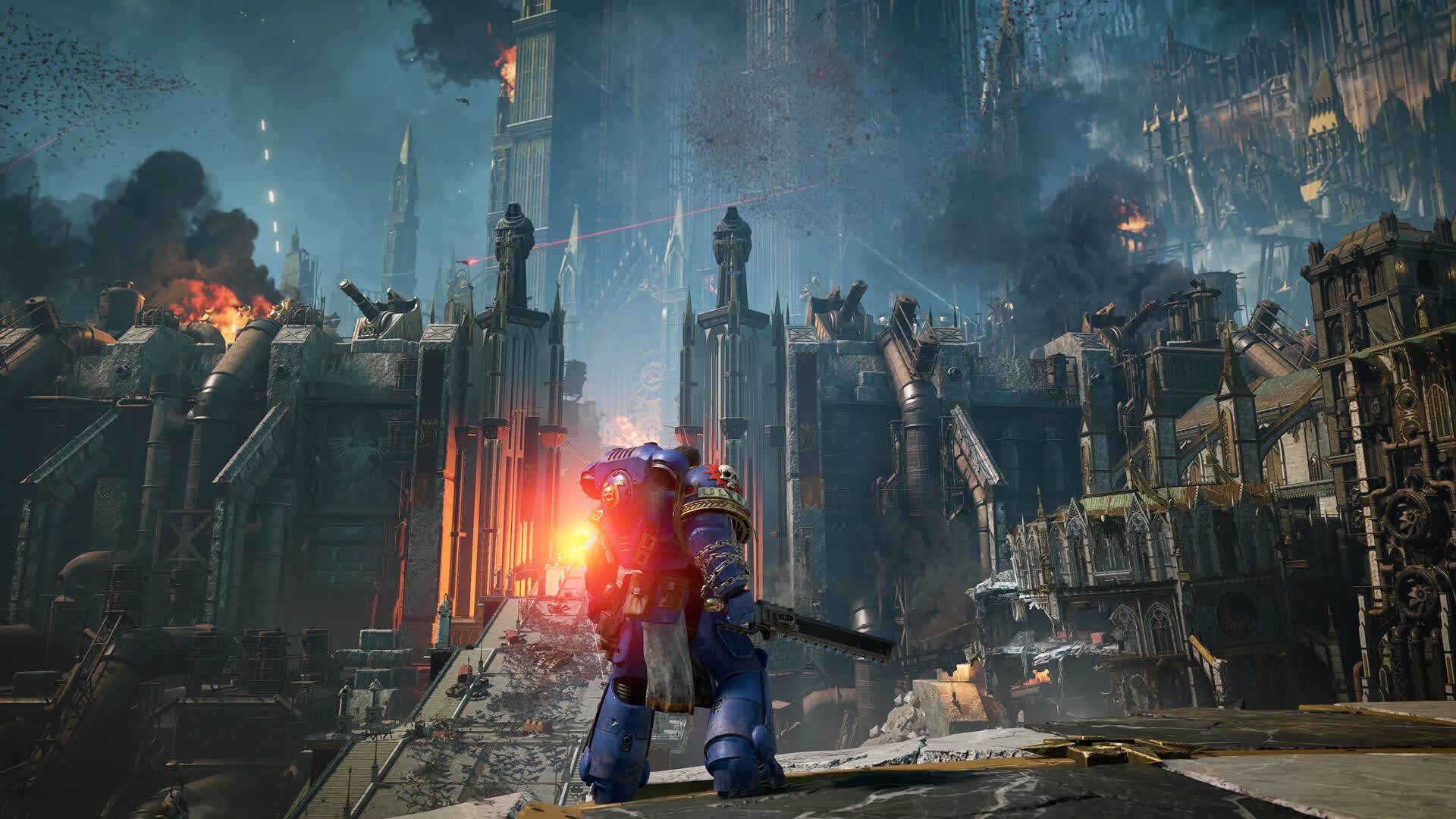
For testing the GeForce GPUs, we used Game Ready Driver 560.94, and for the Radeon GPUs, Adrenalin Edition 24.10.37.10. We’ve also included the Intel Arc A770 using driver version 32.0.101.5989.
Test Setup
| CPU | AMD Ryzen 7 7800X3D |
| Cooling | be quiet! Pure Loop 2 FX 360mm |
| Motherboard | Gigabyte X670E Aorus Master [BIOS F32b] |
| Memory | G.Skill Trident Z5 RGB 32GB DDR5-6000 [CL30-38-38-96] |
| ATX Case | MSI Prospect 700R |
| Power Supply | Kolink Regulator Gold ATX 3.0 1200W |
| Storage | TeamGroup T-Force Cardea A440 M.2 PCle 4 NVMe SSD 4TB |
| Operating System | Windows 11 |
| Display Driver | Nvidia Game Ready Driver 560.94 |
| AMD Adrenalin Edition 24.10.37.10 | |
| Intel Arc 32.0.101.5989 |
Now let’s get into the data…
Benchmarks
Ultra Quality 1080p Native
Starting with the native 1080p data using the Ultra preset, we see that most of the high-end GPUs are capped at around 110 fps, and this is with the Ryzen 7 7800X3D. Essentially, the 7900 GRE or anything faster is CPU-limited under these conditions. The 7800 XT was good for 100 fps, which is great to see. While we are only at 1080p, this is native 1080p, so the results are decent.
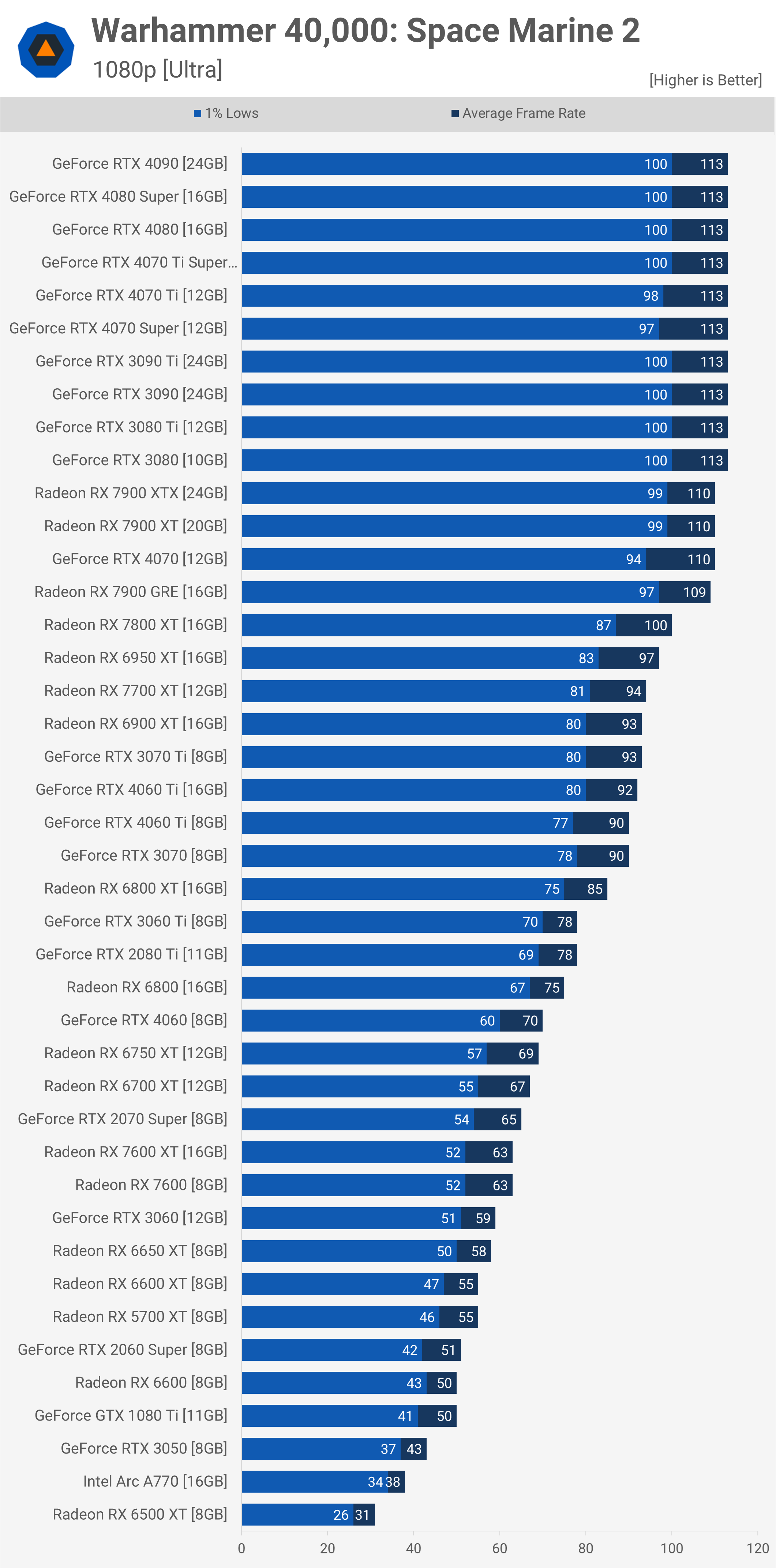
This also means that for 90 fps or better, you only need a 4060 Ti or 7700 XT, and again, this is with the game maxed out visually. Even previous-generation mid-range parts, such as the RTX 3070 and 6800 XT, are delivering well over 60 fps.
For 60 fps or better, the 7600/7600 XT will work, along with older models like the 2070 Super or 6700 XT. The RTX 4060 was 11% faster than the 7600, which is convenient, given it’s also meant to cost 11% more.
The old 5700 XT is still performing well with 55 fps on average, making it 8% faster than the RTX 2060 Super and almost 30% faster than the RTX 3050. Intel’s Arc A770 is struggling here with just 38 fps, making it faster than only the 6500 XT – and we all know how we feel about the 6500 XT.
Ultra Quality 1080p Upscaling
With ‘Quality’ upscaling enabled – DLSS for the GeForce GPUs that support it and FSR for everything else – we find a wide range of GPUs that are able to push close to the CPU limit. In fact, starting from the RTX 3060 Ti and up, we are fairly heavily CPU-limited. Even older parts, such as the RTX 2080 Ti, were able to render 100 fps. The 6900 XT averaged 102 fps, and the RTX 3090 was also heavily CPU-limited.
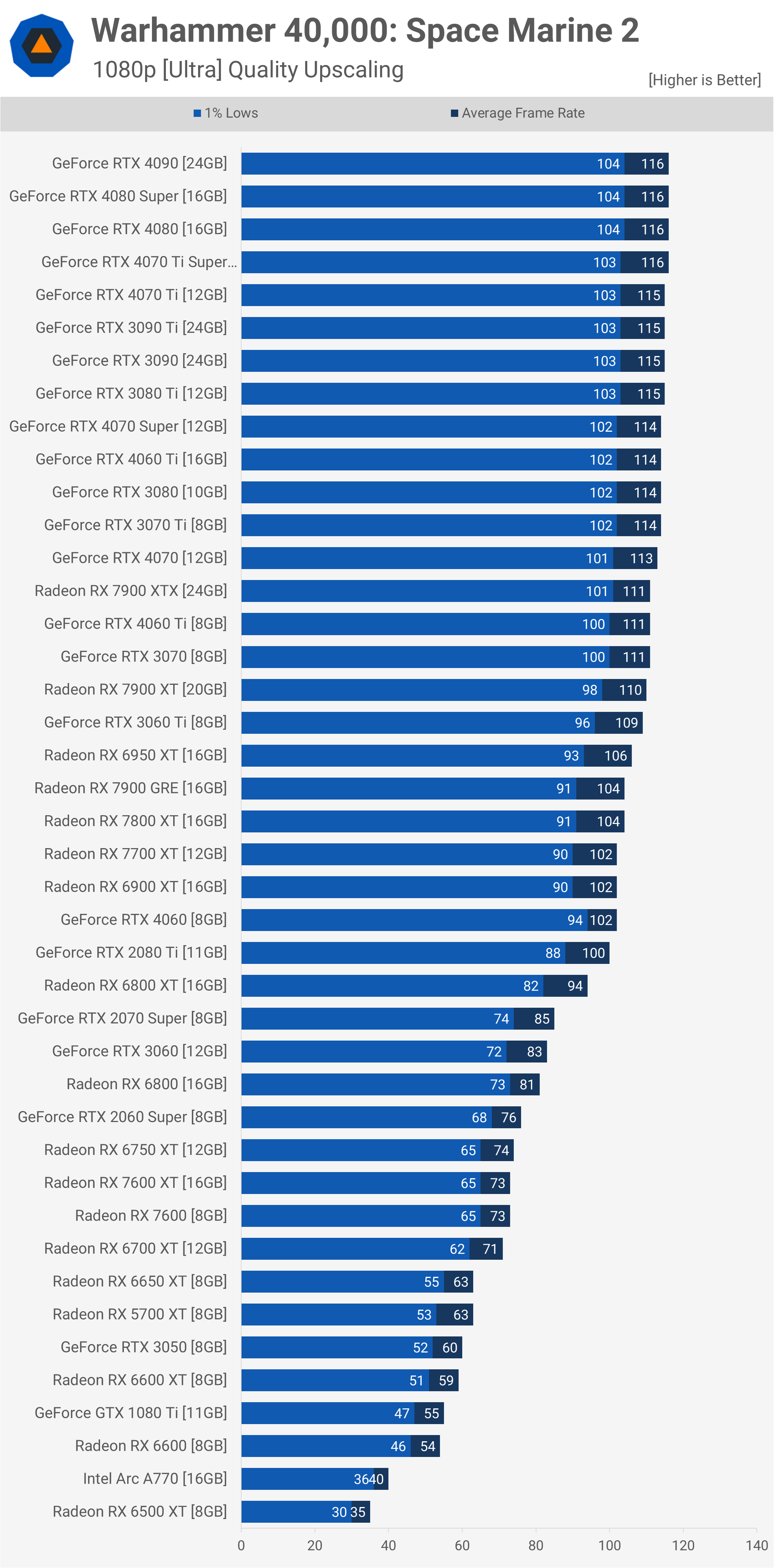
Achieving 60 fps was relatively easy, as the RTX 3050 managed it, while the 5700 XT and 6650 XT both averaged 63 fps.
Ultra Quality 1440p Native
Increasing the resolution to 1440p helps alleviate the CPU bottleneck as fewer GPUs can render well over 100 fps using the Ultra preset. We find the usual suspects at the top of our graph, and although we expected the Radeon GPUs to scale better with the CPU bottleneck, that doesn’t seem to be the case here. The 7900 XTX is hardly slow, though, with 107 fps, and the 7900 XT matched the 4070 Ti.
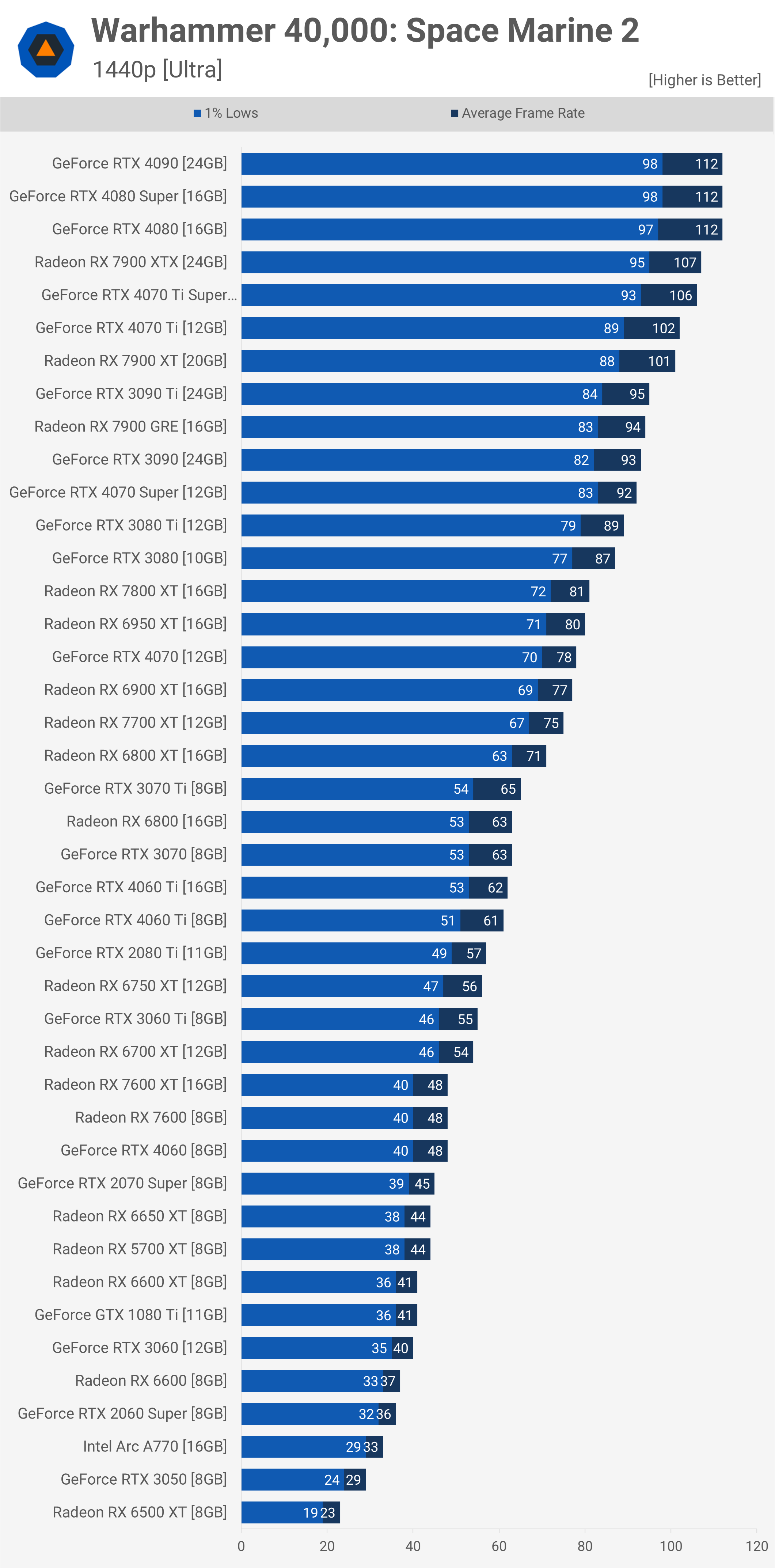
The 7800 XT and RTX 4070 were good for around 80 fps, and for those satisfied with 60 fps, the 4060 Ti works, though the 7700 XT was much better, hitting 75 fps. Below the 4060 Ti, performance starts to drop off, and before you know it, we’re in the sub-50 fps range. At that point, you’ll want to either lower the quality settings or drop down to 1080p.
Ultra Quality 1440p Upscaling
Enabling upscaling, which is essentially a way of lowering the resolution, can dramatically boost performance, even when using the Quality upscaling option. For example, the 7700 XT gains an additional 13% performance, increasing from 75 to 85 fps. It’s also possible to average 60 fps with the 6700 XT, an 11% improvement that results in an extra 6 fps.
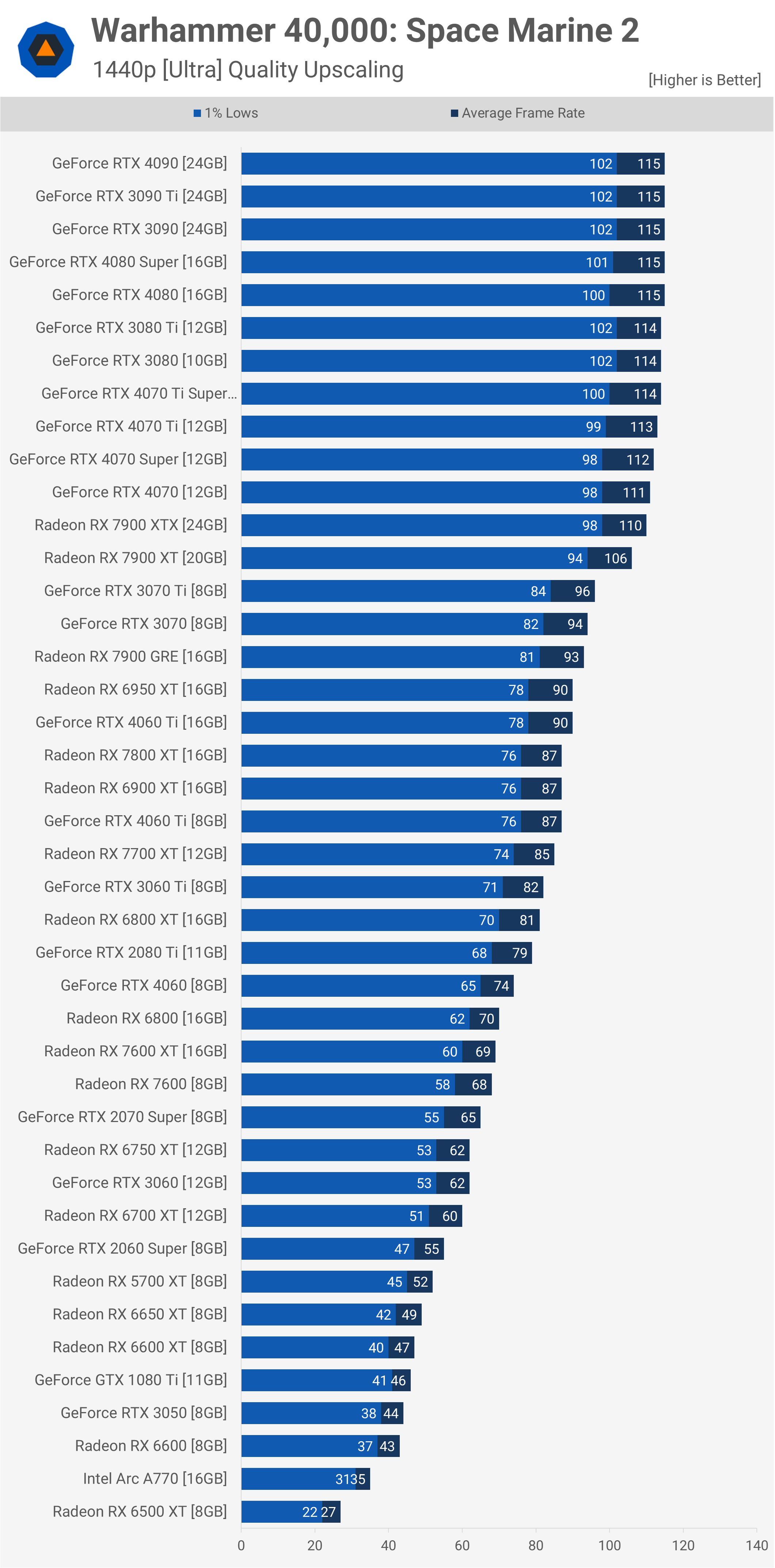
Ultra Quality 4K Native
At 4K, without upscaling, things get tough for these GPUs. Even the RTX 4090 can’t render more than 100 fps on average, falling just short with 95 fps. Quite surprisingly, however, the 7900 XTX is the second fastest GPU here, rendering 77 fps, making it 15% faster than the RTX 4080 Super. In fact, the 7900 XT is able to match the RTX 4080, while the GRE matched the 4070 Ti Super, so the Radeon GPUs are performing extremely well here.
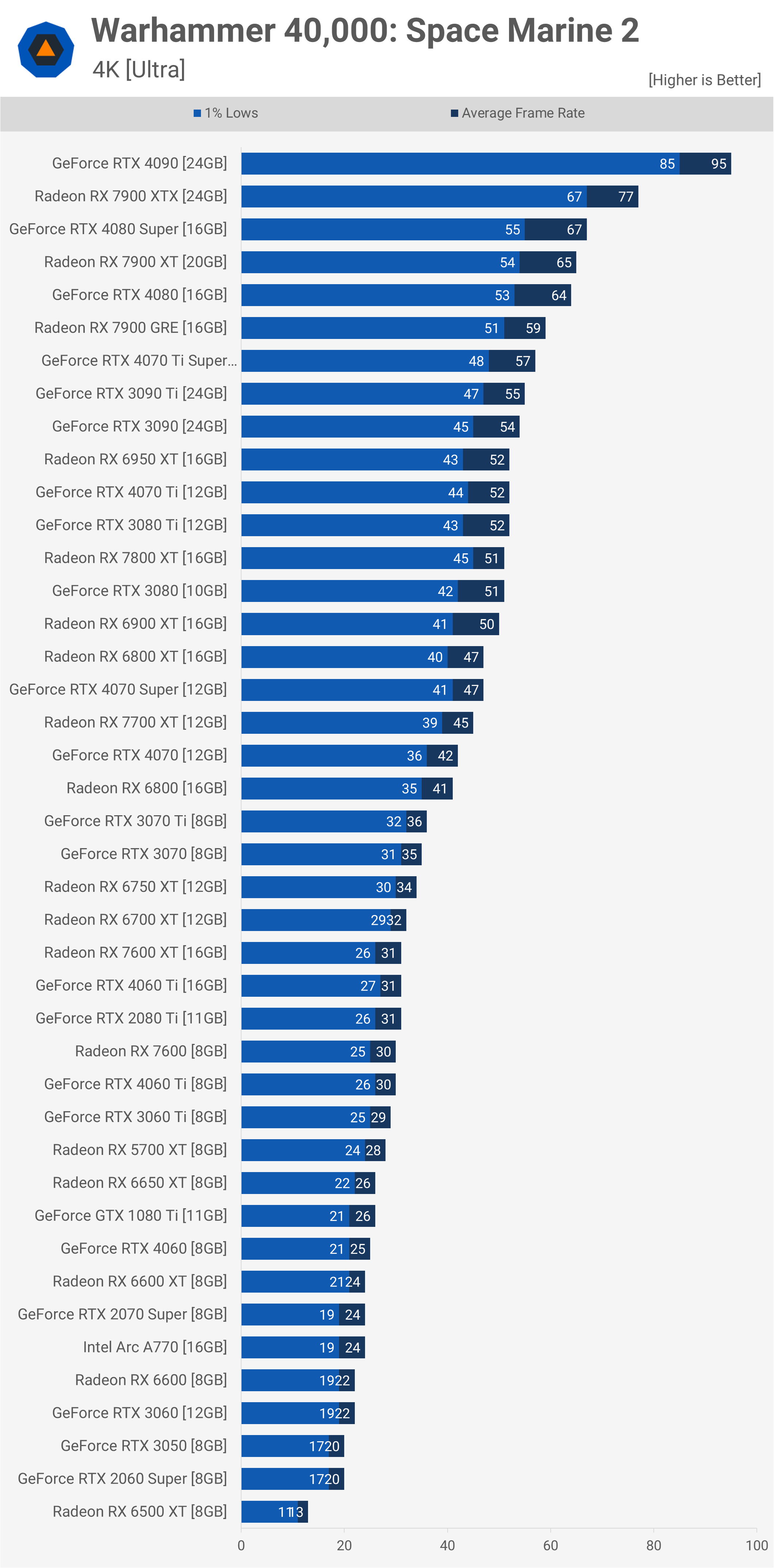
The 7700 XT is roughly matching the RTX 4070 Super, and unbelievably, the 7600 XT is also matching the RTX 4060 Ti, albeit with just 31 fps.
Ultra Quality 4K Upscaling
With Quality upscaling enabled, the 7900 XTX gains only an additional 17% in performance, making it slower than even the 4070 Ti Super. This is because the 4070 Ti Super saw a massive 63% performance increase with DLSS Quality enabled.
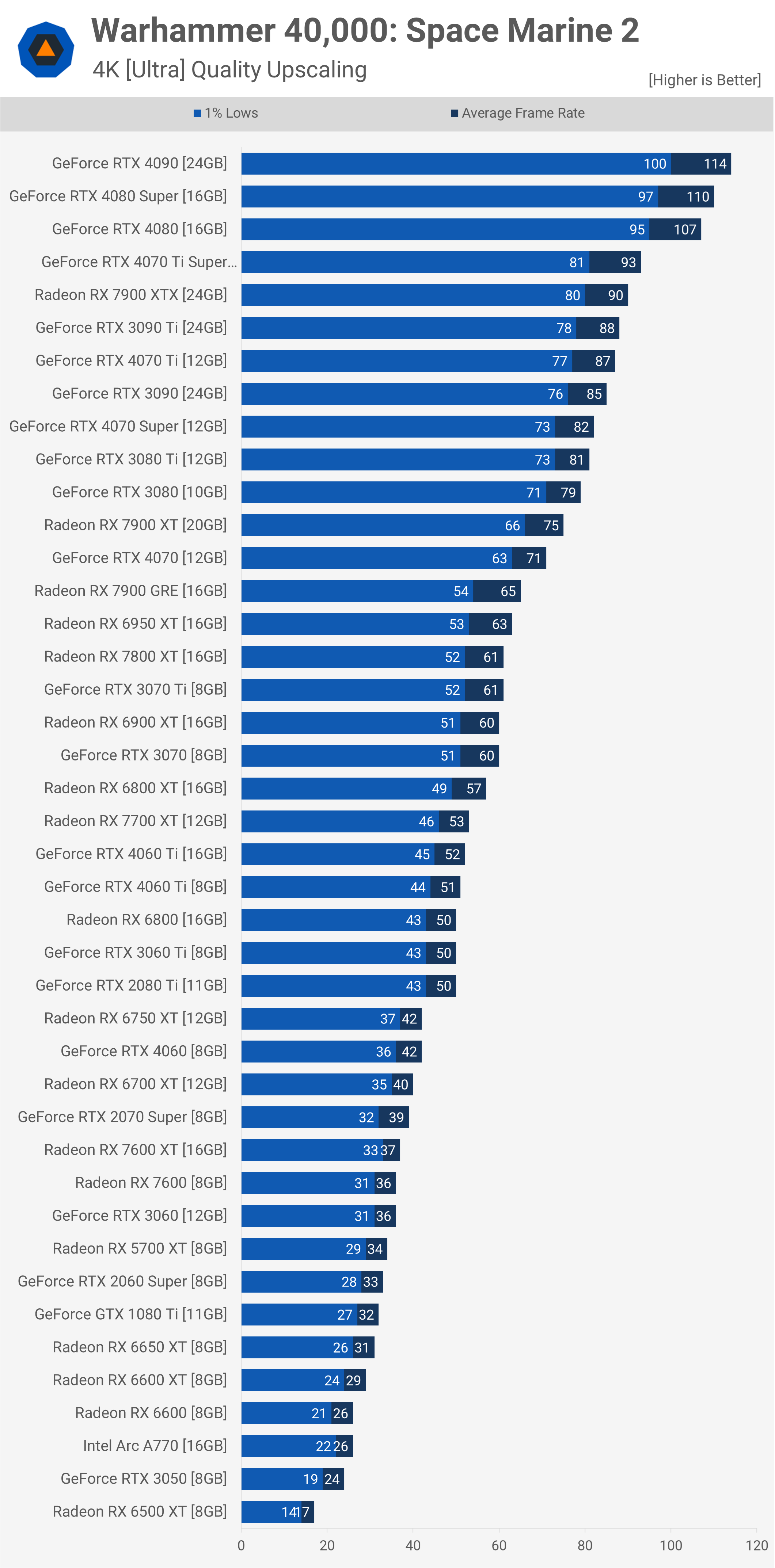
It seems there’s a bug with FSR in the game right now, as performance with FSR is inconsistent. For example, the Radeon RX 7600 XT saw a solid 44% performance uplift with FSR enabled at 1440p, but at 4K, that margin is reduced to just 19%. My advice is to take the upscaling data with a grain of salt for now and instead focus on the native resolution numbers.
High Quality 1080p Native
Once again, much of the data for the higher-end GPUs is CPU-limited, starting from the 7900 GRE and up.
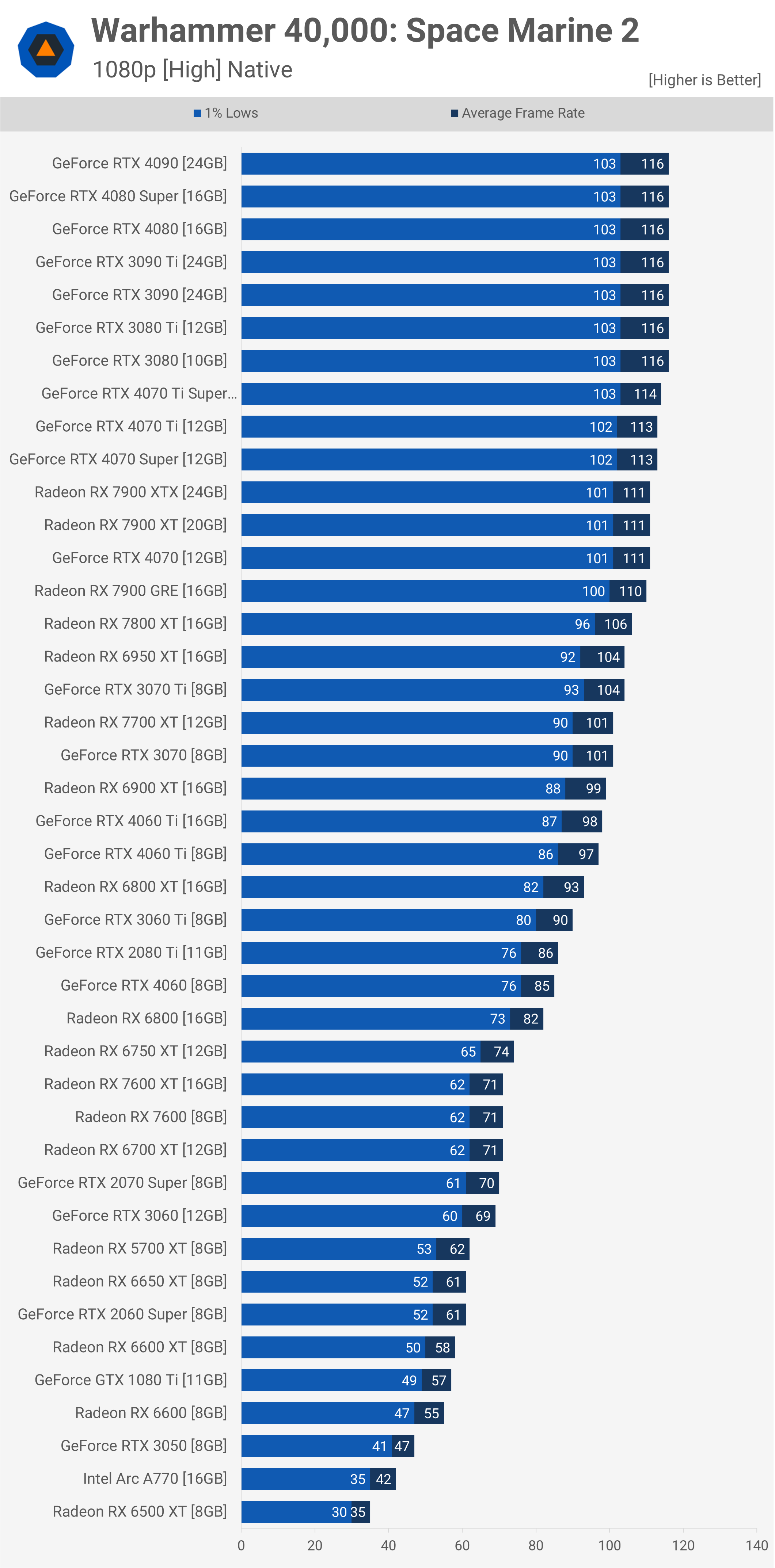
For around 100 fps on average, the RTX 4060 Ti or, preferably, the 7700 XT performs well. From the RX 6800 to the 7600 XT, we see a significant drop in performance, with the RTX 3060, 2070 Super, 6700 XT, and 7600 all averaging in the 70 fps range.
Rendering 60 fps with the High preset at 1080p is relatively easy, and even the 2060 Super handles it, along with the 5700 XT.
High Quality 1440p Native
Moving up to 1440p, we again find that performance is CPU-limited from the 7900 XT and up, though you could probably include the RTX 3090 series GPUs as well. The 7900 GRE achieves 100 fps, making it slightly slower than the 4070 Super.
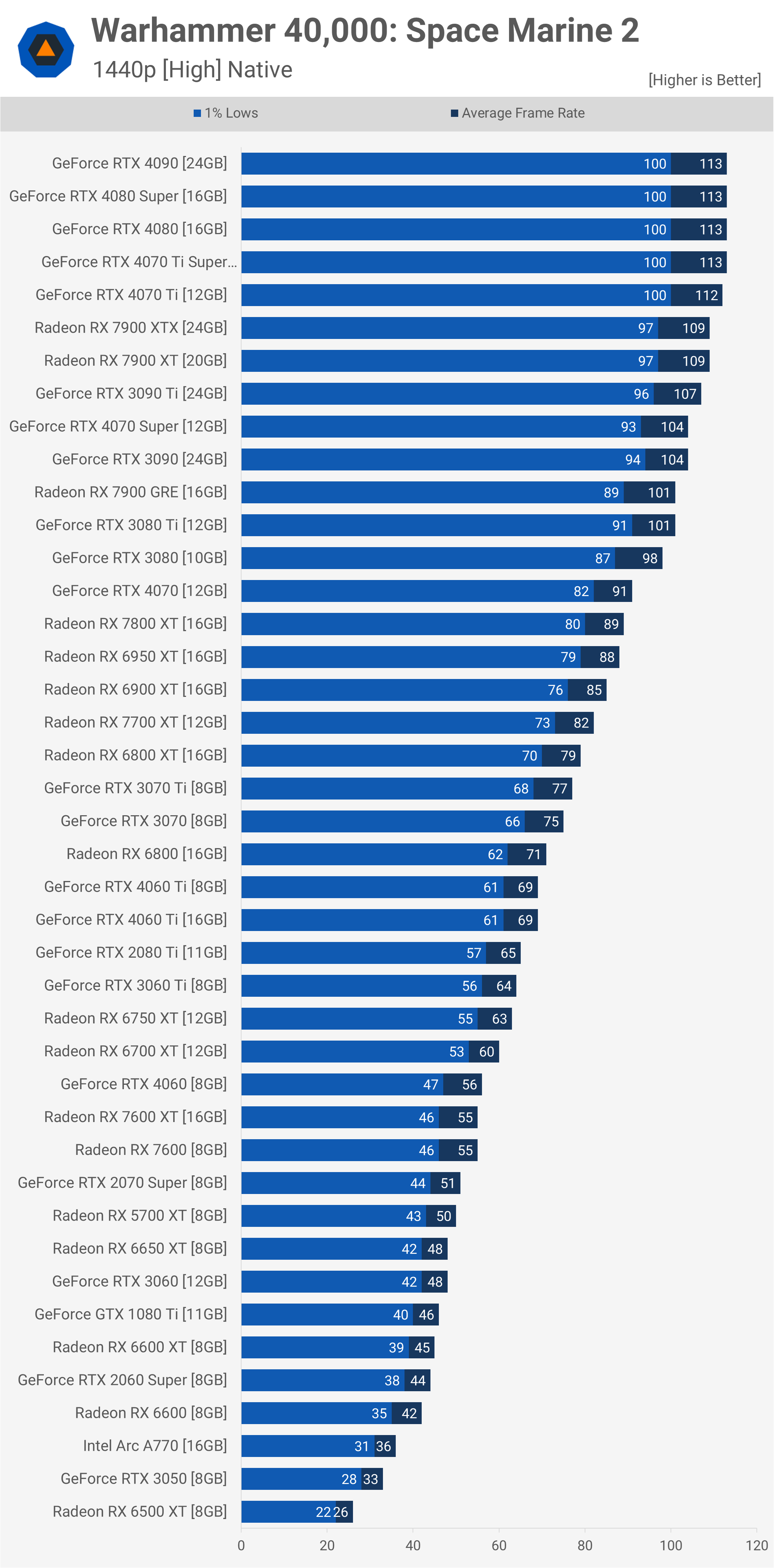
Meanwhile, the 7800 XT and RTX 4070 are neck and neck at around 90 fps, with the 7700 XT averaging 82 fps, making it almost 20% faster than the 4060 Ti. Just below 60 fps, we find the RTX 4060 and 7600/7600 XT, which are only slightly faster than the old 2070 Super and 5700 XT.
Beyond that, you will likely want to lower the quality settings or resolution.
High Quality 4K Native
At 4K, the CPU limits are removed, allowing us to observe the true GPU performance at the high end. The 7900 XT and 4080 Super are closely matched, with the Radeon GPU being 4% faster, while the 7900 XT is 2% slower than the standard RTX 4080.
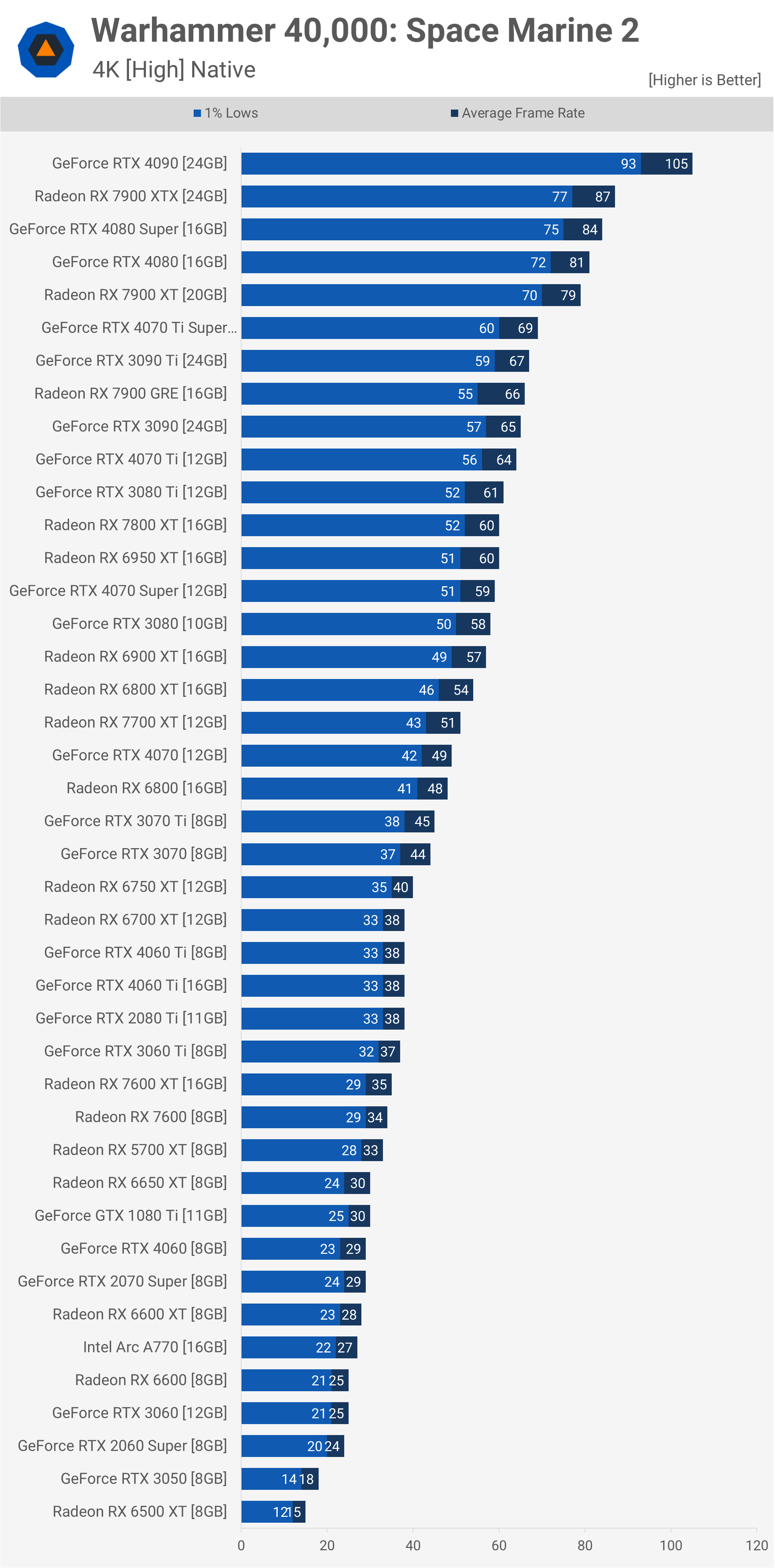
Beyond that, we drop well below 80 fps, with the 4070 Ti Super averaging 69 fps, the 3090 Ti at 67 fps, and the 7900 GRE at 66 fps. Still, for a 60 fps experience, the 7800 XT or 4070 Super will perform well.
Medium Quality 1080p Native
Lowering the quality preset to Medium only improved performance by 5-10% at 1080p, depending on the GPU. However, this was enough to push the RTX 4060 Ti past 100 fps, a mere 6% improvement from the High preset. Overall, dropping down to Medium doesn’t change much here; a few more GPUs break the 100 fps barrier, but at the low end, performance remains mostly the same.
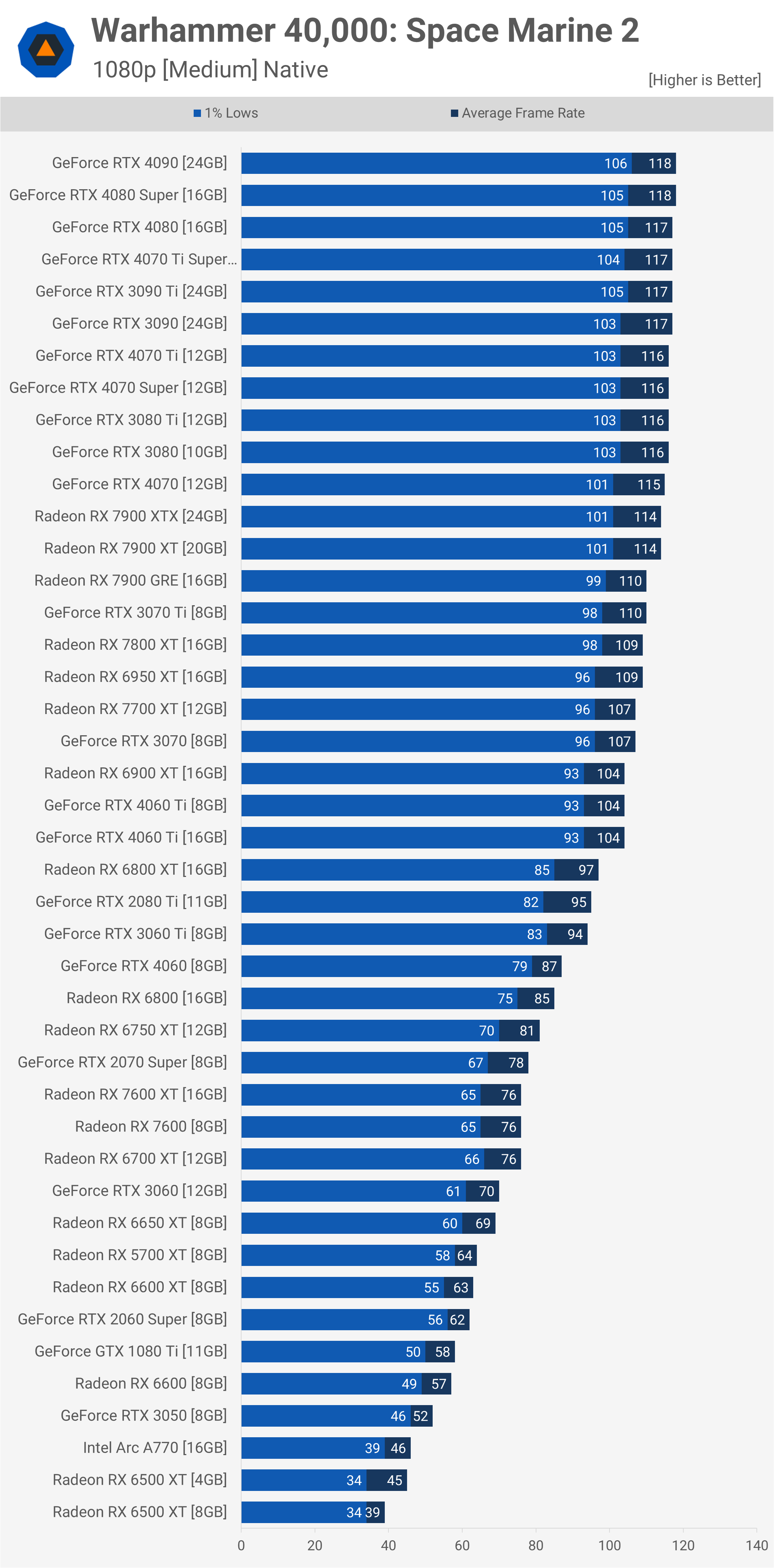
That said, we included the 4GB version of the 6500 XT, and the results are interesting. The fps counter claims the 4GB model is 15% faster than the 8GB model, which can’t be right. Technically, though, it is – since the game doesn’t work properly on the 4GB card. Most textures are missing, and the game is completely broken, with player characters and game assets disappearing entirely. We’ll show you what this looks like shortly.
Medium Quality 1440p Native
Even at 1440p, we’re only seeing a minor performance improvement with the Medium preset compared to High. Not much changes here; for around 100 fps, the 7900 GRE or RTX 3080 will suffice. The RTX 4070 just falls short and isn’t much faster than the 7800 XT. The 7700 XT clears 60 fps easily, with 88 fps on average, which is impressive compared to the 74 fps of the RTX 4060 Ti.
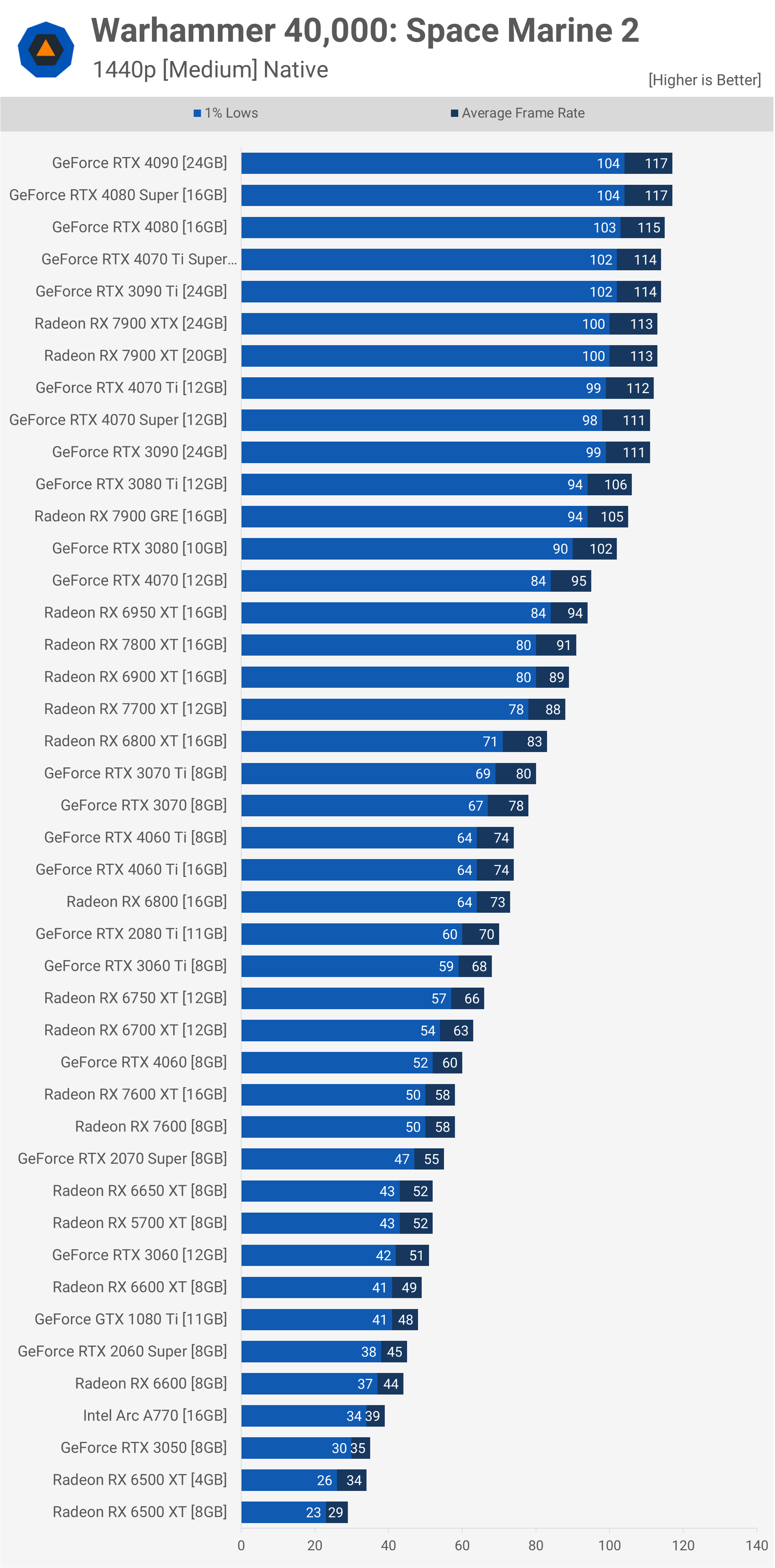
For around 60 fps, the RTX 4060 and 7600/7600 XT will suffice, though performance from these current-generation, entry-level products isn’t particularly impressive, especially considering they cost $300.
Medium Quality 4K Native
At 4K, the RTX 4090 is good for 110 fps, which is about where the 7800X3D starts to limit performance. The 7900 XTX is again very impressive with 93 fps, making it 15% faster than the 4080 Super. The 7900 XT was able to match the 4080 Super. The 4070 Ti Super was on par with the 7900 GRE, while the 7800 XT and 4070 Super were comparable at around 60 fps. Beyond that, you’ll want to lower the resolution.
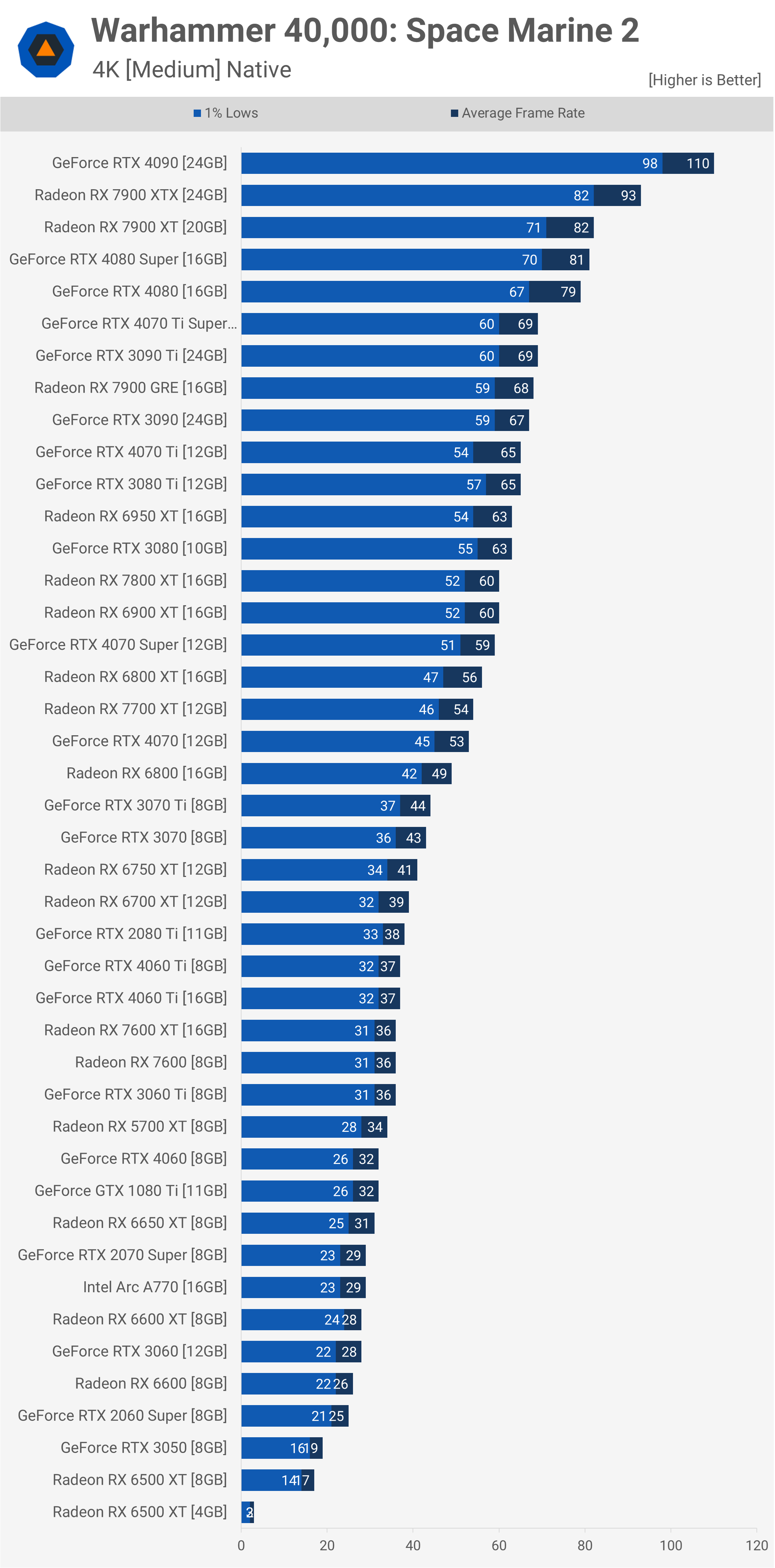
VRAM Usage
The game will warn you about insufficient VRAM on 8GB cards when using the Ultra preset, and while we did see VRAM usage reach around 8GB, it never really exceeded that in our testing. That said, it could in other sections of the game, but based on this initial testing, it seems as though 8GB of VRAM will suffice for Ultra settings.
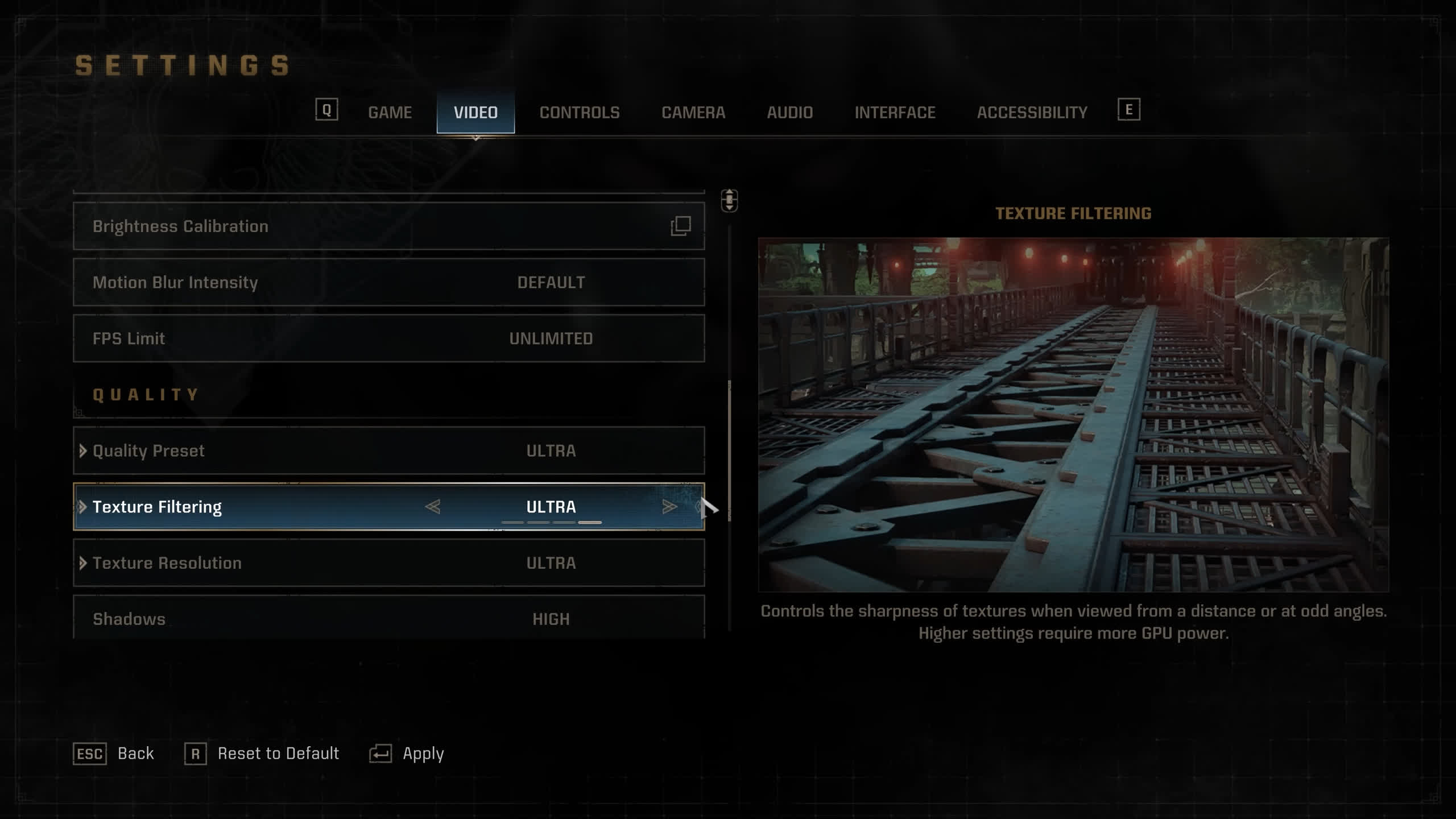
So, 8GB cards survive to fight another new AAA title. However, we’re not surprised by this. Space Marine 2 is a decent-looking game, but the real draw here is the massive battles, not the breathtaking visuals. With that in mind, it’s acceptable that, for the most part, texture quality is quite poor. Some textures look okay – great, even – but many look outdated upon closer inspection.
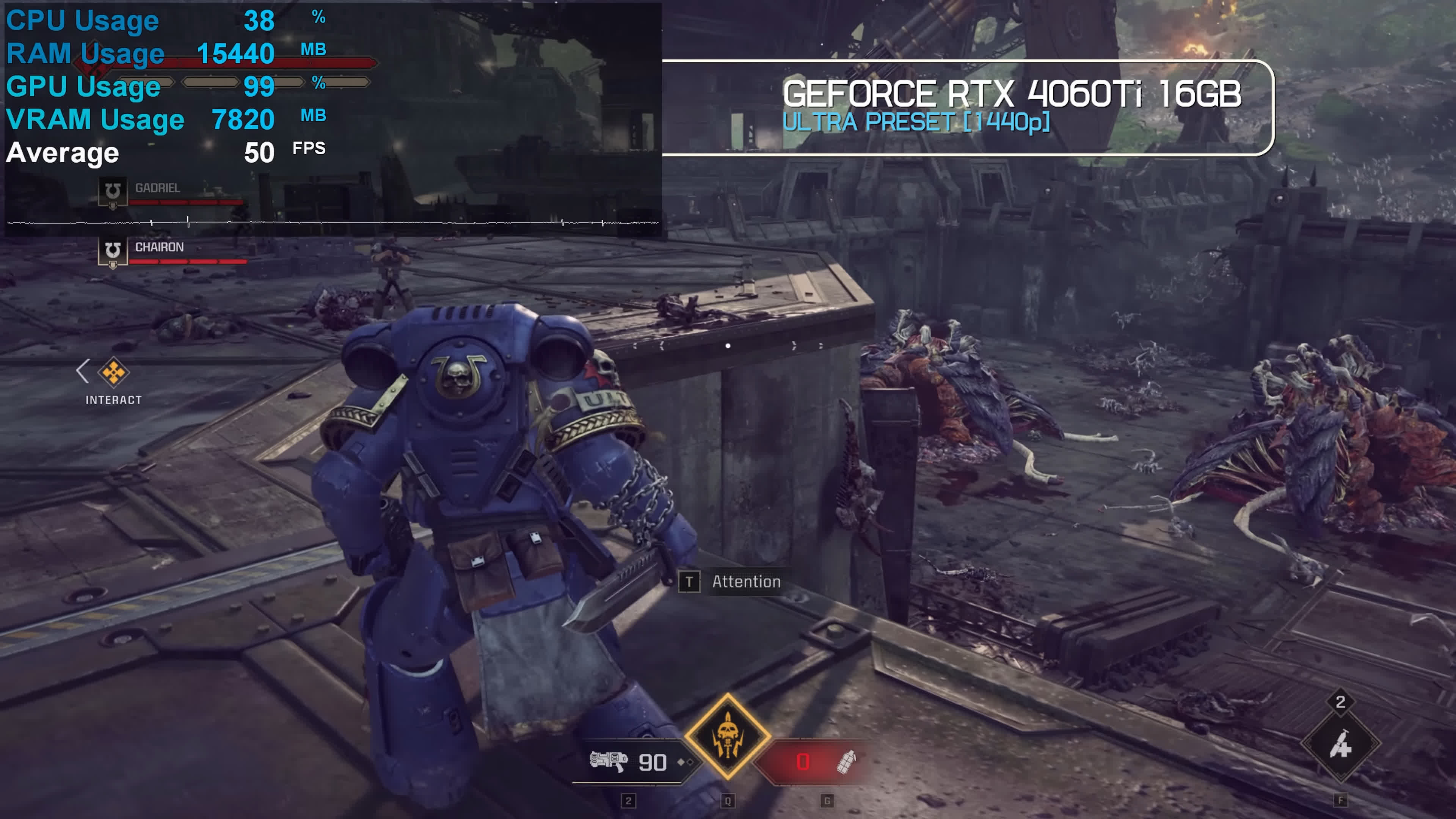
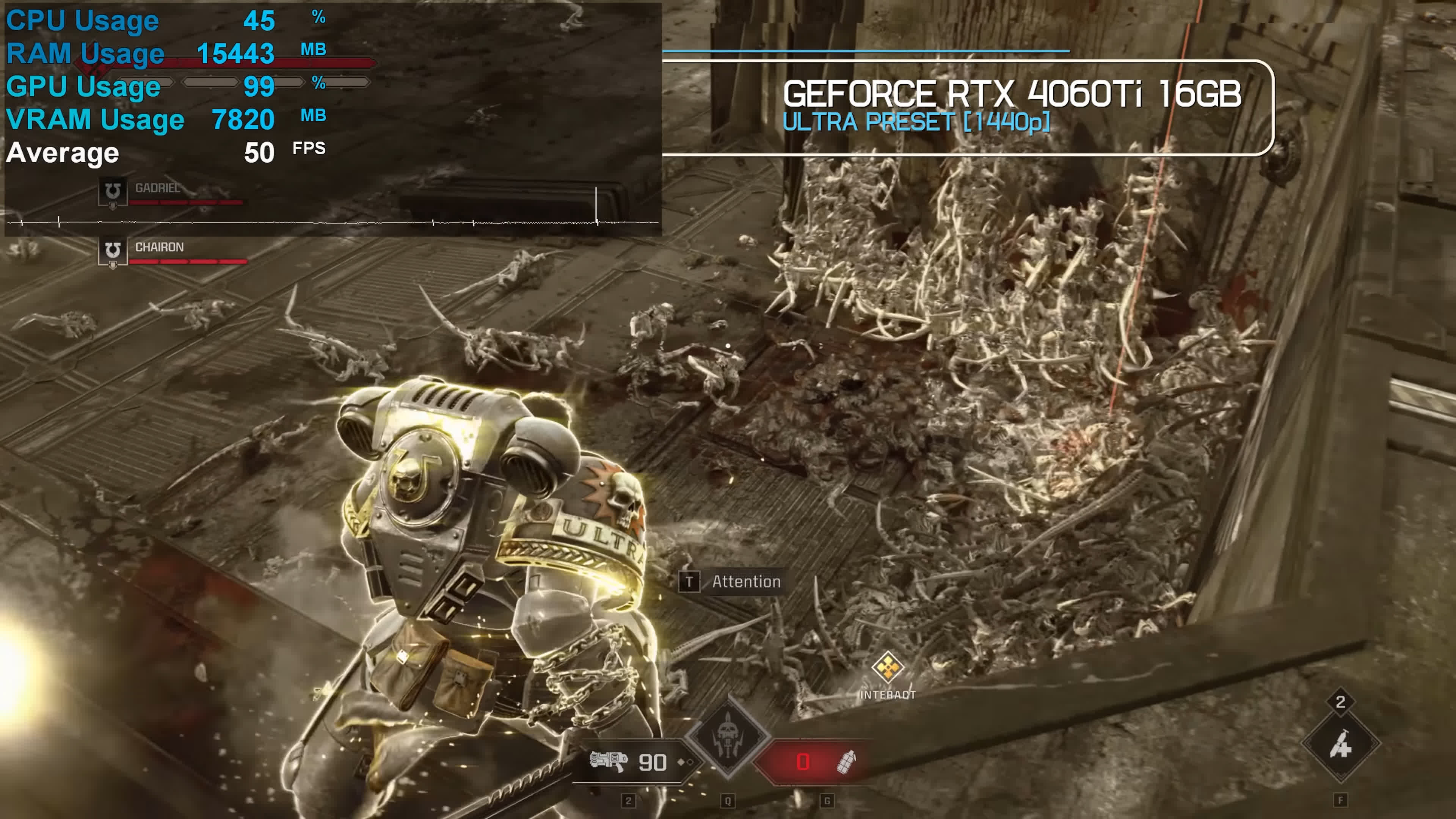
While 8GB is sufficient for this title, it’s also kind of the minimum. Although we didn’t test any 6GB models, we’ve seen reports and evidence that 6GB cards suffer similar issues to 4GB cards. Let’s take a look at that now.
Textures and Visual Comparison: 8GB vs 4GB
For reference, the video below shows how the game looks using the 8GB version of the 6500 XT at 1080p with the Medium preset. Ignore the frame rate – it’s still a 6500 XT – but this is how the game should look. If you’re wondering, this is exactly how it looks using an RTX 4090, for example. While texture quality isn’t amazing, the level of detail is quite good, the render distance is impressive, and the number of enemies is incredible.
For a better representation of image quality comparisons, check out the HUB video below:

Later on you will see how the 4GB version of the 6500 XT looks like, and right away you’ll notice a few things. Again, this is 1080p Medium testing. The character model textures are very muddy, and this applies to everything. The big cannon no longer exists, many game assets are missing, and all NPCs – both supporting characters and enemies – are gone, meaning the game is obviously broken.
In the side-by-side comparison – if the previous footage wasn’t clear enough – with just 4GB of VRAM, all the enemies are missing, and the red lasers are appearing out of nowhere. Textures look terrible, and even some buildings are missing.
We also tried lowering the quality preset to Low, and even then, the game was still broken on the 4GB card. This footage is from the Low preset at 1080p with performance upscaling, and it looks terrible. Even here, the enemies are still missing. Just for fun, we lowered the resolution to 800×600 with performance upscaling still enabled, and even at this lowest possible setting, the game remained broken. So, for our 4GB friends, it’s safe to say it’s time to upgrade.
What We Learned
Overall, Space Marine 2 is a great-looking game with intense horde battles. Although many of the texture details can make the game look a bit dated when viewed up close, for this style of game, it’s not something that will bother too many players. However, it’s unfortunate because if the texture quality were higher, the game would be visually stunning. We encountered a similar issue with Black Myth: Wukong, though it seems to be more pronounced in Space Marine 2.
In terms of GPU requirements, the game isn’t extreme. Using the High preset at 1440p, most GPUs can render over 60 fps, and if you’re happy to enable upscaling, the game should be very easy to run. That said, there appears to be an issue with FSR scaling, which should be addressed in a future patch.
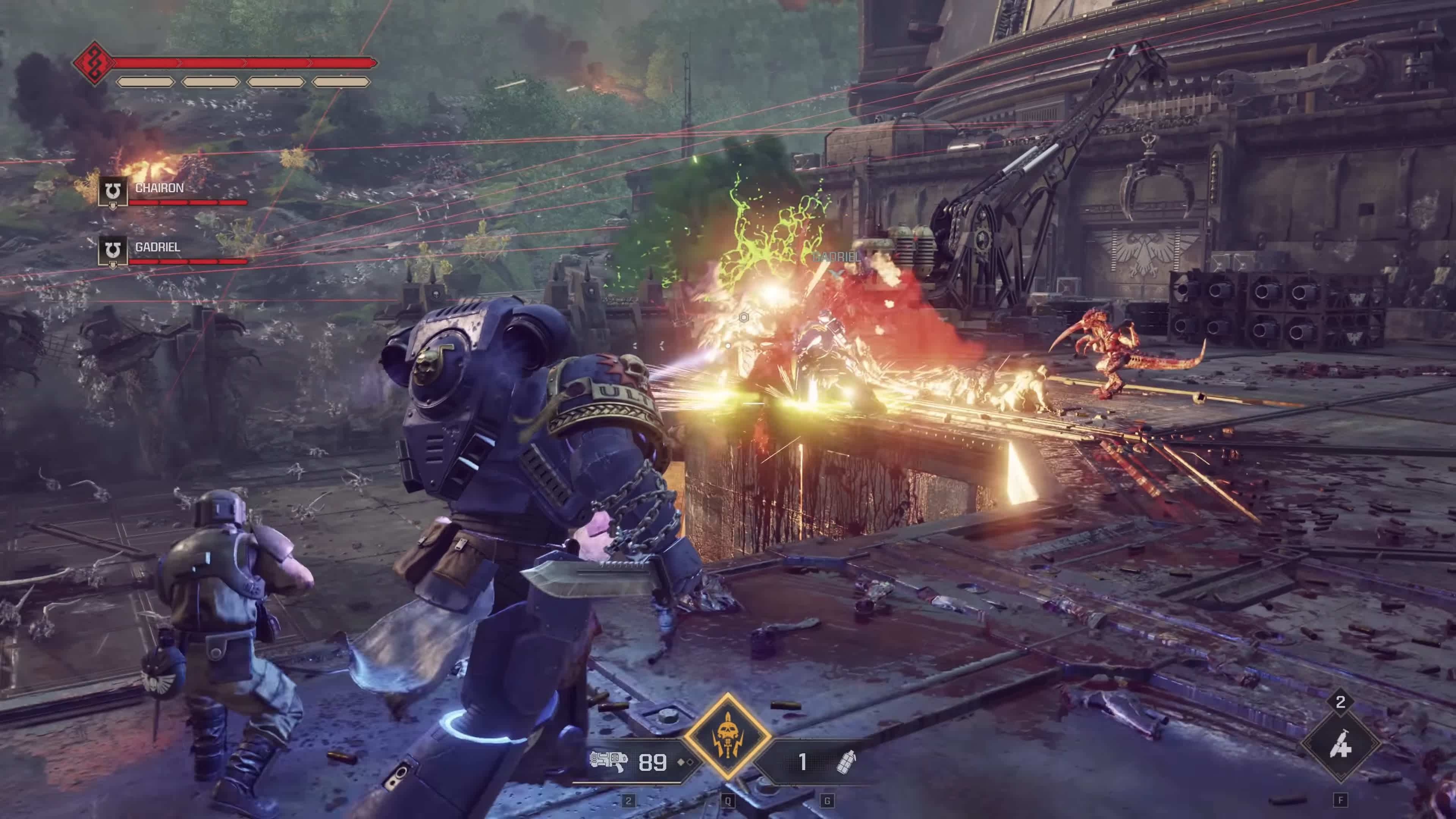
DLSS, on the other hand, was working superbly. At 1440p using the Ultra preset with Quality upscaling, you can achieve over 60 fps on an RTX 3060, or over 80 fps with the 3060 Ti, while the 4060 Ti was pushing 90 fps.
Keep in mind that we are testing a very demanding section of the game, so between the big battles, you’re likely to see much higher frame rates. This is largely due to the removal of CPU limits in less intense scenes.
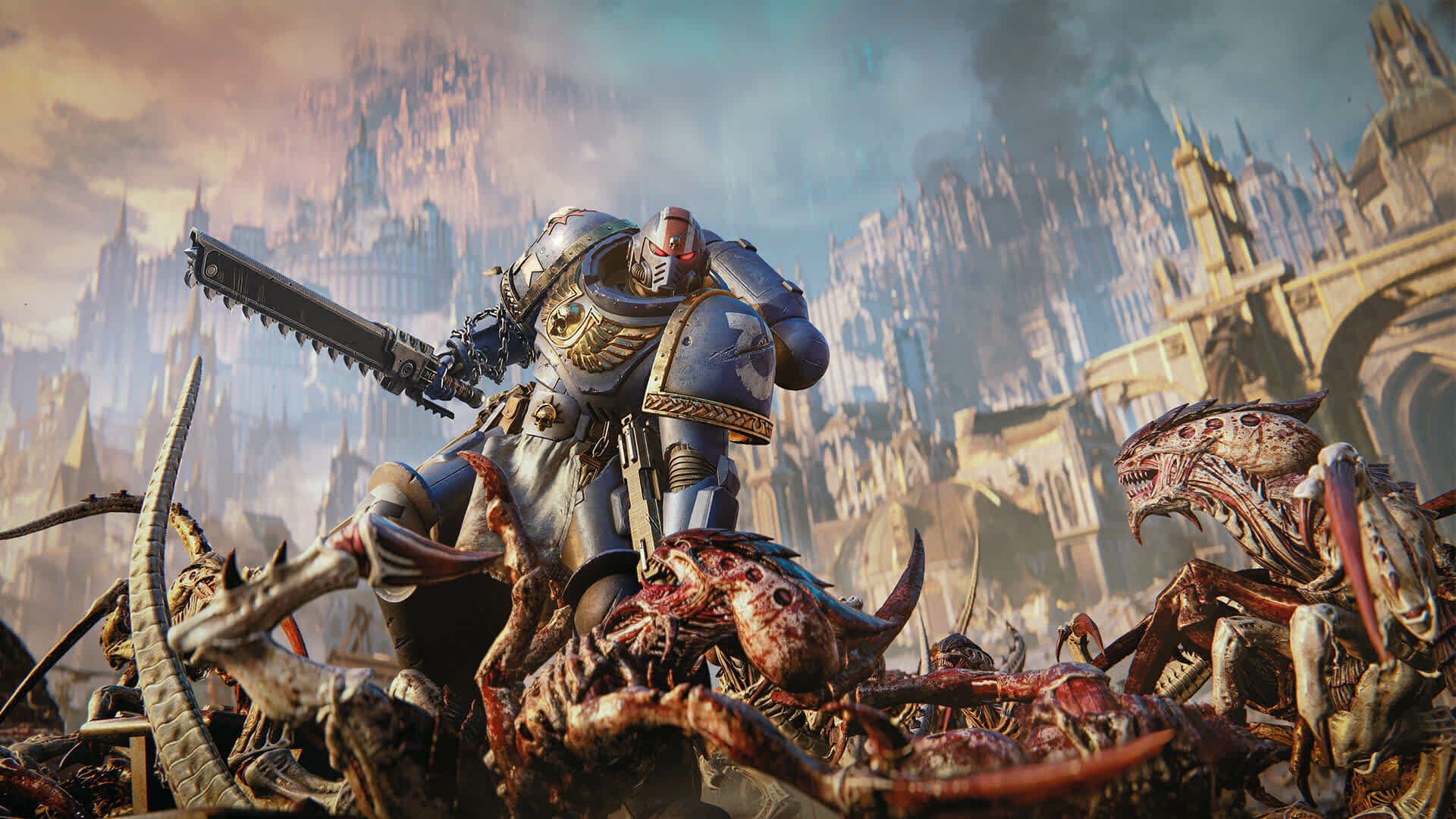
On that note, there’s a good chance your CPU, rather than your GPU, will be the limiting factor in this title, especially if you lower the visuals in search of higher frame rates. However, we are yet to test a range of CPUs with this title, so we’re not exactly sure what the CPU scaling looks like.
Space Marine 2 is shaping up to be a game we’ll use for both CPU and GPU testing for quite some time, so we’ll be monitoring any updates. Let us know what kind of performance you’re seeing and if you’re enjoying playing this game.
Shopping Shortcuts:
- Nvidia GeForce RTX 4070 Ti Super on Amazon
- Nvidia GeForce RTX 4080 Super on Amazon
- Nvidia GeForce RTX 4090 on Amazon
- Nvidia GeForce RTX 4070 Super on Amazon
- AMD Radeon RX 7800 XT on Amazon
- AMD Radeon RX 7900 XT on Amazon
- AMD Radeon RX 7900 XTX on Amazon

